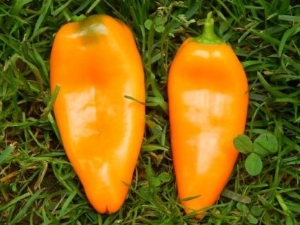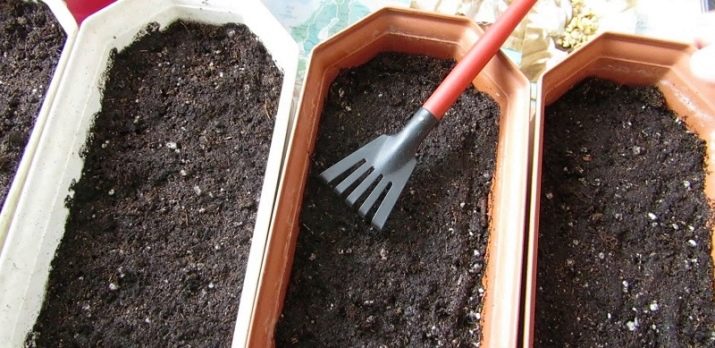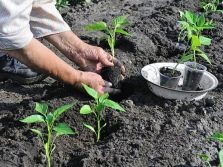Characteristics and cultivation of pepper "Orange"

Sweet pepper is the favorite delicacy of most lovers of fresh vegetables.Many species of this culture are grown on the territory of Russia. Each variety has certain characteristics and cultivation features. In the article, we consider the Orange Pepper, which attracted the attention of the majority of summer residents due to a number of positive characteristics.
Brief description of the form
The vegetable got its name due to the bright orange color of the fruit. Also, this variety can also be represented by yellow and red peppers. Experts claim that the vegetable is ideal for cultivation in a climate typical of Russia. Cultivating varieties are engaged in both experienced gardeners and novices in this field.
The popularity and prevalence of the species has gained due to the excellent taste, yield and other positive qualities, which we denote in the article.
Fruit
The main characteristics of the fruit are as follows:
- Pepper "Orange" has a small size, its length reaches 10 centimeters;
- average fruit weight is about 40 grams;
- wall thickness does not exceed 0.5 cm;
- the surface of the fruit is smooth and even, with a characteristic glossy shine;
- vegetables are protected by thin skin.
Special features
Experts believe that the main distinctive features of the “Orange” type are high taste and smell. The composition of the fruit contains a lot of natural sugar, which gives the harvest sweetness and richness. Also in the pepper contains many beneficial trace elements and vitamins, including beta-carotene and vitamin C, necessary for a strong immune system.
Due to excellent gastronomic qualities, pepper is often eaten raw, however, the vegetable is also ideal for preparing snacks, salads, casseroles and other dishes. Many housewives choose this variety for billets for the winter.
Orange peppers make tasty and healthy candied fruits due to the absence of excess moisture in the vegetable. In this format, the product is stored for a long time, retaining many useful elements. Also, the view is recommended for children and people who lead a healthy lifestyle.
Advantages and disadvantages
Advantages:
- attractive and bright appearance (this characteristic is especially important from a commercial point of view);
- wonderful taste;
- high content of trace elements that have a positive effect on health;
- a vegetable can maintain freshness for a long time under certain storage conditions;
- abundant yield;
- hypoallergenic product.
Disadvantages:
- relatively small size;
- the plant is temperature sensitive;
- need for tying a shrub.
After analyzing the positive and negative qualities, we can say that the disadvantages are insignificant.
Agrotechnical features of the plant
Vegetable culture is intended both for cultivation in an open ground, and on the basis of greenhouses and hotbeds. This variety is usually chosen gardeners medium and northwestern latitudes of our country. As a method of cultivation, preference is given to a seedling method. The size of the plant is compact. In height it reaches forty centimeters. Due to the small size of the shrubs can be planted in small areas.
On one "square" of the earth will fit 5 plants. The term of maturation of the crop is from 95 to 110 days from the time of sowing the seeds. As soon as the shrubs begin to bear fruit, they are abundantly covered with medium-sized fruits in an amount of about 30 pieces. The yield is about 7 kilograms per square meter of plantations.
These figures are considered standard. With proper care and cultivation in protected ground, this figure is much higher.
Care
To get a rich and high-quality harvest by the end of the season, it is not enough just to buy seeds. Seed must be properly prepared and germinated. Works are carried out in strictly allotted time. After growing seedlings need to properly take care of the plant, fertilizing, watering and hilling.The process of cultivated vegetable culture consists of several stages, each of which is important.
Seed preparation
Quality seeds, which are offered by leading brands, are already selected, processed and calibrated. If you collect them yourself, you must select the material used. To do this, the seeds are placed in warm water. Floated grains are thrown away. These are dummies that do not have a germ. Seeds that have gone to the bottom can be safely used for germination.
This is followed by a pickle. The most popular method without the use of chemicals - bubbling. The selected material is placed in a container with warm water for 24 hours and treated with air bubbles. For work, you can use a normal aquarium compressor. The second technique, which is widespread - put the seeds in a solution of manganese (2%). Some gardeners also use the agate and apron fungicides. Before dropping into the solution, the grains are placed in a small bag of cloth. Keep in liquid for 20 minutes.
Recommendations of specialists
Experienced growers use special ready-made tools that can be bought at any themed store. The drugs are sold ready to use with instructions for use. Such compositions are very popular: "Epin-Extra" and "Ideal". Growth stimulants will reduce the time spent on plant development, and protective drugs will make it more resistant to diseases and pests. Folk remedies are also widely used. The seeds are treated with a solution of ash: 20 grams of ash per liter of water. Seeds are placed in a liquid for 5 hours.
Soil preparation
For the vegetable of the above varieties prepare a special mixture:
- peat - 1 part;
- turf - 1 part;
- humus - 2 parts.
All components are thoroughly mixed. They add 2 cups of ash. Next, the earth mixture must be etched in the mandatory case. The most effective and simplest way is to spray the soil with a solution of potassium permanganate (2%). The next method of processing is to leave the ground outside in sub-zero temperatures. The soil is kept in bags for one and a half months during the frost period. Also used heat treatment. Boxes of soil are placed in the oven at a maximum temperature of 100 degrees Celsius.
Some gardeners prefer to farm the land on the steam bath for 30 minutes.
Sowing on seedlings
It is necessary to start growing seedlings of pepper in the following terms:
- for open ground - mid-March;
- for greenhouses and greenhouses - the first decade of February.
As the soil for germination use as ready-made mixtures, sold in a wide variety, and the soil, prepared independently (mixed peat, sand, earth and humus). Container for cultivation is used any. The most budget option - plastic cups. Ideal small peat pots. To begin with, seeds are germinated and only then they are planted in the ground. The seed will be placed in a humid microclimate with an air temperature of at least 27 degrees Celsius. Under these conditions, sprouts germinate in the period from 5 to 10 days. After the seeds are placed in the soil to a depth of 0.5-1 millimeter.
Creation of conditions
In order for the plant to develop fully, it is necessary to ensure optimal light day. It must be at least 12 hours. To achieve this indicator in a natural way during the winter period is impossible, therefore it is necessary to use additional light sources, such as fluorescent lamps and various reflective materials.
In the process of cultivation, seedlings are fertilized only once in 2 weeks. Experts recommend using complex ready-made compositions as feedings, such as Nitrofoska, Florist Rost, Kornevin and others. Ideal temperature conditions for growing seedlings of the variety "Orange" - from 22 to 23 degrees Celsius.
Ordinary wooden boxes will fit perfectly in the form of packaging for seedlings if the seeds are planted together, rather than in separate containers.
Landing
As soon as the seedlings of peppers reached the age of 45-50 days, it was time to land. In order for shrubs to take root well in conditions of a different climate, two weeks prior to transplantation, they are periodically taken out to fresh air for quenching. The frequency of stay of pepper seedlings on the street should be gradually increased. To begin with, the plants are left for 30 minutes, as a result, the duration is increased to a full day of light.
Planted in a loose and nutritious land. This is a guarantee of active growth and a rich harvest. The composition of the soil is mixed with sand, compost, peat and sawdust treated with urea. You can also feed the soil on the site with hydrogel. It is used to maintain optimal moisture. Ratio: 1 gram of substance per liter of soil. On the territory of the site pre-make holes for seedlings. The soil is moistened, the seedlings are transplanted carefully so as not to damage the root system.
Reviews
About 90% of all responses, characterizing the variety "Orange", are positive. Russian summer residents noted a high percentage of seed germination, excellent fruit taste and abundant yield. In the negative reviews were small sizes of pepper.
Most growers recommend this crop for cultivation.
In the next video you are waiting for the 10 most common mistakes made by gardeners when growing peppers.































